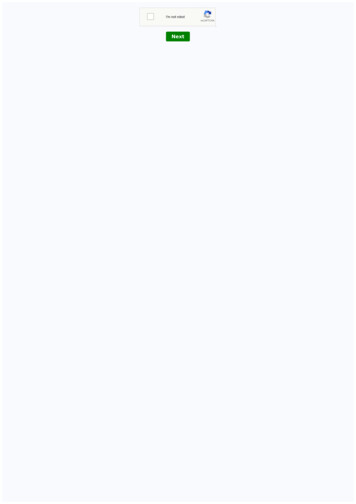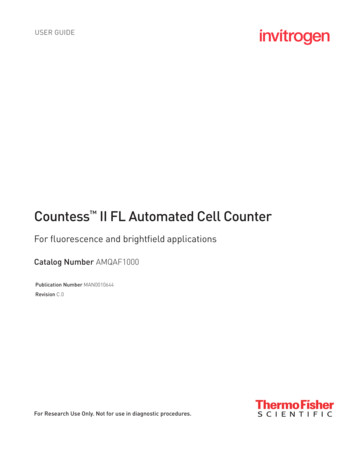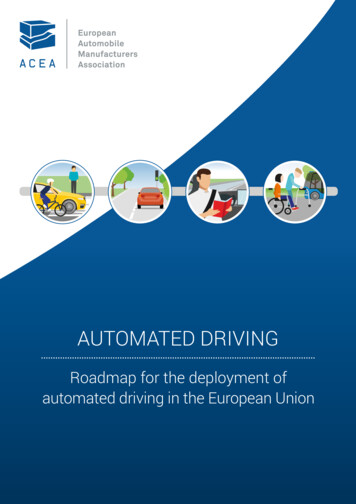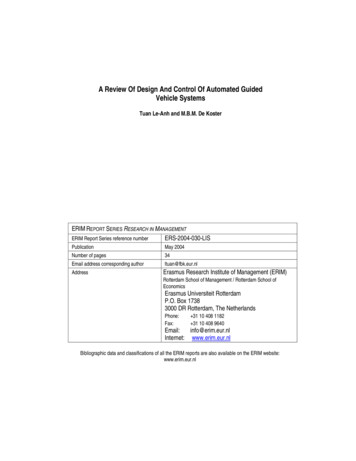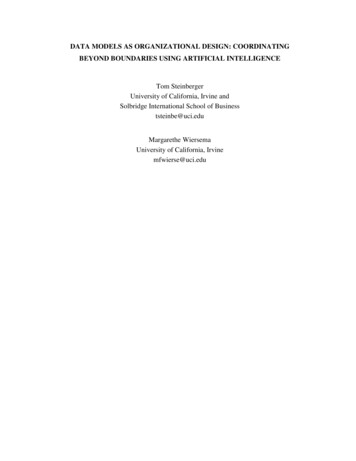
Transcription
Language Learning & une 2008, Volume 12, Number 2pp. 94-112BEYOND THE DESIGN OF AUTOMATED WRITING EVALUATION:PEDAGOGICAL PRACTICES AND PERCEIVED LEARNINGEFFECTIVENESS IN EFL WRITING CLASSESChi-Fen Emily Chen and Wei-Yuan Eugene ChengNational Kaohsiung First University of Science and Technology, TaiwanAutomated writing evaluation (AWE) software is designed to provide instant computergenerated scores for a submitted essay along with diagnostic feedback. Most studies onAWE have been conducted on psychometric evaluations of its validity; however, studieson how effectively AWE is used in writing classes as a pedagogical tool are limited. Thisstudy employs a naturalistic classroom-based approach to explore the interaction betweenhow an AWE program, MY Access!, was implemented in three different ways in three EFLcollege writing classes in Taiwan and how students perceived its effectiveness inimproving writing. The findings show that, although the implementation of AWE was notin general perceived very positively by the three classes, it was perceived comparativelymore favorably when the program was used to facilitate students’ early drafting andrevising process, followed by human feedback from both the teacher and peers during thelater process. This study also reveals that the autonomous use of AWE as a surrogatewriting coach with minimal human facilitation caused frustration to students and limitedtheir learning of writing. In addition, teachers’ attitudes toward AWE use and theirtechnology-use skills, as well as students’ learner characteristics and goals for learning towrite, may also play vital roles in determining the effectiveness of AWE. With limitationsinherent in the design of AWE technology, language teachers need to be more criticallyaware that the implementation of AWE requires well thought-out pedagogical designs andthorough considerations for its relevance to the objectives of the learning of writing.INTRODUCTIONAutomated writing evaluation (AWE), also referred to as automated essay scoring (AES)1, is not a brandnew technology in the twenty-first century; rather, it has been under development since the 1960s. Thistechnology was originally designed to reduce the heavy load of grading a large number of student essaysand to save time in the grading process. Early AWE programs, such as Project Essay Grade, employedsimple style analyses of surface linguistic features of a text to evaluate writing quality (Page, 2003). Sincethe mid-1990s, the design of AWE programs has been improving rapidly due to the advance of artificialintelligence technology, in particular natural language processing and intelligent language tutoringsystems. Newly developed AWE programs, such as Criterion with the essay scoring engine "e-rater" byEducational Testing Service and MY Access! with the essay scoring engine "Intellimetric" by VantageLearning, boast the ability to conduct more sophisticated analyses including lexical complexity, syntacticvariety, discourse structures, grammatical usage, word choice, and content development. They provideimmediate scores along with diagnostic feedback in various aspects of writing and can be used for bothformative and summative assessment purposes. In addition, a number of AWE programs are now webbased and equipped with a variety of online writing resources (e.g., thesauri and word banks) and editingfeatures (e.g., grammar, spelling, and style checkers), which make them not only an essay assessment toolbut also a writing assistance tool. Students can make use of both AWE’s assessment and assistancefunctions to help them write and revise their essays in a self-regulated learning environment.Although AWE developers claim that their programs are able to assess and respond to student writing ashuman readers do (e.g., Attali & Burstein, 2006; Vantage Learning, 2007), critics of AWE express strongskepticism. Voices from the academic community presented in Ericsson and Haswell’s (2006) anthology,Copyright 2008, ISSN 1094-350194
Chi-Fen Emily Chen & Wei-Yuan Eugene ChengBeyond the Design of Automated Writing Evaluationfor example, question the truth of the industry’s publicity for AWE products and the consequences of theimplementation of AWE in writing classes. They distrust the ability of computers to "read" texts andevaluate the quality of writing because computers are unable to understand meaning in the way humansdo. They also doubt the value of writing to a machine rather than to a real audience, since no genuine,meaningful communication is likely to be carried out between the writer and the machine. Moreover, theyworry whether AWE will lead students to focus only on surface features and formulaic patterns withoutgiving sufficient attention to meaning in writing their essays.The development and the use of AWE, however, is not a simple black-and-white issue; rather, this issueinvolves a complex mix of factors concerning software design, pedagogical practices, and learningcontexts. Given the fact that many AWE programs have already been in use and involve multiplestakeholders, a blanket rejection of these products may not be a viable, practical stand (Whithaus, 2006).What we need are more investigations and discussions of how AWE programs are used in various writingclasses "in order to explicate the potential value for teaching and learning as well as the potential harm"(Williamson, 2004, p. 100). A more pressing question, accordingly, is probably not whether AWE shouldbe used but how this new technology can be used to achieve more desirable learning outcomes whileavoiding potential harms that may result from limitations inherent in the technology. The present study,therefore, employed a naturalistic classroom-based approach to explore how an AWE program wasimplemented in three EFL college writing classes and how student perceptions of the effectiveness ofAWE use were affected by different pedagogical practices.LITERATURE REVIEWAssessment Validation of AWE: Theory-Based Validity and Context ValidityAWE programs have been promoted by their developers as a cost-effective option of replacing orenhancing human input in assessing and responding to student writing2. Due to AWE vendors’ relentlesspromotion coupled with an increasing demand for technology use in educational institutions, more andmore teachers and students have used, are using, or are considering using this technology, thus makingresearch on AWE urgently important (Ericsson & Haswell, 2006; Shermis & Burstein, 2003a;Warschauer & Ware, 2006). Most of the research on AWE, however, has been funded by AWEdevelopers, serving to promote commercial vitality and support refinement of their products. Industryfunded AWE studies have been mostly concerned with psychometric issues with a focus on theinstrument validity of AWE scoring systems. They generally report high agreement rates between AWEscoring systems and human raters. They also demonstrate that the scores given by AWE systems andthose by other measures of the same writing construct are strongly correlated (see Dikli, 2006; Keith,2003; Phillips, 2007). These findings aim to ensure AWE scoring systems’ construct validity and provideevidence that AWE can rate student writing as well as humans do.Assessment validation, however, is more complex than simply comparing scores from different raters ormeasures. Chung and Baker (2003) caution that "high reliability or agreement between automated andhuman scoring is a necessary, but insufficient condition for validity" (p. 29). As Weir (2005) points out,construct validity should not be seen purely as "a matter of the a posteriori statistical validation," but italso needs to be viewed as an "a priori investigation of what should be elicited by the test before its actualadministration" (p. 17). Weir stresses the importance of the non-statistical a priori validation and suggeststhat "theory-based validity" and "context validity" are crucial for language assessment. From a sociocognitive approach, Weir notes that these two types of validity have "a symbiotic relationship" and areinfluenced by, and in turn influence, the criteria or construct used for marking as part of scoring validity(p. 20). He calls special attention to the role of context in language assessment, as context highlights thesocial dimension of language use and serves as an essential determinant of communicative languageability.Language Learning & Technology95
Chi-Fen Emily Chen & Wei-Yuan Eugene ChengBeyond the Design of Automated Writing EvaluationTo examine the theory-based validity of AWE, we need to discuss what writing is from a theoreticalperspective. A currently accepted view of writing employs a socio-cognitive model emphasizing writingas a communicative, meaning-making act. Writing requires not only linguistic ability for formal accuracybut, more importantly, meaning negotiation with readers for genuine communicative purposes. Writingthus needs to take into account both internal language processing and contextual factors that affect howtexts are composed and read (Flower, 1994; Grabe & Kaplan, 1996; Hyland, 2003). Most AWE programs,however, are theoretically grounded in a cognitive information-processing model, which does not focuson the social and communicative dimensions of writing. They treat texts solely as "code" devoid ofsociocultural contexts and "process them as meaningless ‘bits’ or tiny fragments of the mosaic ofmeaning" (Ericsson, 2006, p. 36). They "read" student essays against generic forms and presetinformation, but show no concern for human audiences in real-world contexts.Even the Conference on College Composition and Communication (CCCC) in the U.S. has expresseddisapproval of using AWE programs for any assessment purpose and made a strong criticism: "Whilethey [AWE programs] may promise consistency, they distort the very nature of writing as a complex andcontext-rich interaction between people. They simplify writing in ways that can mislead writers to focusmore on structure and grammar than on what they are saying by using a given structure and style" (CCCC,2006). CCCC’s criticism expresses their concern with not only the theory-based validity of AWEprograms but also a washback effect, or a "consequential validity" (in Weir’s, 2005, terminology): AWEuse may encourage students to write to gain high scores by giving more attention to the surface featuresthat are more easily detected by AWE systems than to the construction of meaning for communicativepurposes (Cheville, 2004).With regard to the context validity, information on how and why AWE is used to assess student writing ineducational contexts is often lacking (Chung & Baker, 2003). When the context and the purpose of usingAWE are unknown, it is difficult to truly judge the validity of AWE programs. In addition, Keith (2003)points out that most psychometric studies on AWE have been conducted on large-scale standardized testsrather than on classroom writing assessments; hence, the validity of AWE could differ in these two typesof contexts. He speculates that the machine-human agreement rate may be lower for classroomassessments, since the content and meaning of student essays is likely to be more valued by classroomteachers.Another important validation issue for AWE is the credibility of the scoring systems. A number of studiesfound that writers can easily fool these systems. For instance, an essay that is lengthy or contains certainlexico-grammatical features preferred by the scoring systems can receive a good score, even though thecontent is less than adequate (Herrington & Moran, 2001; Powers, Burstein, Chodorow, Fowles, &Kukich, 2002; Ware, 2005). Students can thus devise means of beating such systems, rather than makinga real effort to improve their writing. Moreover, since AWE systems process an essay as a series of codes,they fail to recognize either inventive or illogical writing (Cheville, 2004), nor can they recognizenuances such as sarcasm, idioms, and clichés used in student essays (Herrington & Moran, 2001). Whenmeaning and content are more emphasized than form, the fairness of AWE scoring is often called intoquestion.Pedagogical Foundation of AWE: Formative Learning and Learner AutonomyTo enhance their pedagogical value, several AWE programs, such as MY Access! and Criterion, havebeen developed for not only summative but also formative assessment purposes by providing scores anddiagnostic feedback on various rhetorical and formal aspects of writing for every essay draft submitted totheir scoring systems. Students can then use the computer-generated assessment results and diagnosticadvice to help them revise their writing as many times as they need. The instructional efficacy of AWE,as Shermis and Burstein (2003b) suggest, increases when its use moves from that of summativeLanguage Learning & Technology96
Chi-Fen Emily Chen & Wei-Yuan Eugene ChengBeyond the Design of Automated Writing Evaluationevaluation to a more formative role. Though AWE scoring systems’ validity remains contended, theirdiagnostic feedback function seems pedagogically appealing for formative learning.Formative assessment is used to facilitate learning rather than measure learning, as it focuses on the gapbetween present performance and the desired goal, thus helping students to identify areas of strengths andweaknesses in gaining directions for improvement (Black & Wiliam, 1998). For second language (L2)writing, formative feedback, as Hyland (2003) suggests, is particularly crucial in improving andconsolidating learners’ writing skills. It serves as an in-process support that helps learners developstrategies for revising their writing. Formative feedback can therefore support process-writing approachesthat emphasize the need for multiple drafting through a scaffold of prompts, explanations, and suggestions.Although formative feedback is a central aspect of writing instruction, Hyland and Hyland (2006) pointout that research has not been unequivocally positive about its role in L2 writing development since manypedagogical issues regarding feedback remain only partially addressed. The form, the focus, the quality,the means of delivery, the need for, and the purpose of feedback can all affect the usefulness of feedbackin improving writing. These issues are vital not only for human feedback but for automated feedback aswell.Studies on AWE for formative learning, however, have not been able to demonstrate that automatedfeedback is of much help during students’ revising process. The most frequently reported reason is thatautomated feedback provides formulaic comments and generic suggestions for all the submitted revisions.Thus, students may find it of limited use. Moreover, since such feedback is predetermined and unable toprovide context-sensitive responses involving rich negotiation of meaning, it is useful only for therevision of formal aspects of writing but not of content development (Cheville, 2004; Grimes &Warschauer, 2006; Yang, 2004; Yeh & Yu, 2004). Additionally, Yang’s (2004) study reveals that moreadvanced language learners appeared to show less favorable reactions toward the AWE feedback.Learners’ language proficiency may constitute another variable affecting the value of such feedback.AWE programs, like many other CALL tutors, are designed to foster learner autonomy by performingerror diagnosis of learner input, generating individualized feedback, and offering self-access resourcessuch as dictionaries, thesauri, editing tools, and student portfolios. In theory, such programs can provideopportunities for students to direct their own learning, independent of a teacher, to improve their writingthrough constant feedback and assistance features in a self-regulated learning environment. However,whether students can develop more autonomy in revising their writing through computer-generatedfeedback and making use of the self-help writing and editing tools available to them is uncertain. Thismay lead to questions of student attitudes toward and motivation for the use of AWE (Ware, 2005).Additionally, Beatty (2003) cautions that CALL tutors often "follow a lock-step scope and sequence,"thus giving learners "only limited opportunities to organize their own learning or tailor it to their specialneeds" (p. 10). Such a problem may also occur when AWE is used.Vendor-funded studies on AWE programs have demonstrated significant improvement on standardizedwriting tests (e.g., Attali, 2004; Elliot, Darlington, & Mikulas, 2004; Vantage Learning, 2007). Althoughthese results are encouraging, Warschauer and Ware (2006) criticize many of these studies for beingmethodologically unsound and outcome-based. Accordingly, a major problem of this type of research isthat "it leaves the educational process involved as a black box" (p. 14). These studies seem to attribute theobserved writing improvement to the AWE software itself but ignore the importance of learning andteaching processes. Warschauer and Ware thus suggest that research on AWE should investigate "theinteraction between use and outcome" (p. 10), for it can provide a more contextualized understanding ofthe actual use of AWE and its effectiveness in improving writing.One recent classroom-based AWE study on the interaction between use and outcome is particularly worthnoting. Grimes and Warschauer (2006) investigated how MY Access! and Criterion were implemented inU.S. high school writing classes. They found two main benefits of using AWE: increased motivation toLanguage Learning & Technology97
Chi-Fen Emily Chen & Wei-Yuan Eugene ChengBeyond the Design of Automated Writing Evaluationpractice writing for students and easier classroom management for teachers. More importantly, their studyrevealed three paradoxes of using AWE. First, teachers’ positive views of AWE did not contribute tomore frequent use of the programs in class, as teachers needed class time for grammar drills andpreparation for state tests. Second, while teachers often disagreed with the automated scores, they viewedAWE positively because, for students, the speed of responses was a strong motivator to practice writing,and, for teachers, the automated scores allowed them to offload the blame for grades onto a machine.Third, teachers valued AWE for revision, but scheduled little time for it. Students thus made minimal useof automated feedback to revise their writing except to correct spelling, punctuation, and grammaticalerrors. Their revisions were generally superficial and had little improvement in content. In addition, theuse of these two programs did not significantly improve students’ scores on standardized writing tests.The authors caution that AWE can be misused to reinforce artificial, mechanistic, and formulaic writingdisconnected from communication in real-world contexts.Based on the studies reviewed here, it can be concluded that the validity of AWE scoring systems has notbeen thoroughly established and the usefulness of automated feedback remains uncertain in anygeneralized sense. AWE programs, even those designed for formative learning and emphasizing learnerautonomy, do not seem to improve student writing significantly in either form or meaning. Therefore,AWE programs are often suggested to be used as a supplement to writing instruction rather than as areplacement of writing teachers (Shermis & Burstein, 2003b; Ware, 2005; Warschauer & Ware, 2006).Yet, how AWE can be used as an effective supplement in the writing class and how different learningcontexts and pedagogical designs might affect the effectiveness of AWE warrants further investigation.The present study addresses these issues by exploring the interaction between different pedagogicalpractices with an AWE program in three EFL writing classes and student perceptions of learningoutcomes. The purpose is to reveal how different learning/teaching processes affect the perceived value ofAWE in improving students’ writing.METHODOLOGYThe ContextThis study is a naturalistic classroom-based inquiry that was conducted in three EFL college writingclassroom contexts in a university in Taiwan. The three writing classes, for third-year English majors,were taught by three instructors who were all experienced EFL writing teachers. They shared somecommon features in their writing instruction: 1) the three writing courses were required of third-yearTaiwanese college students majoring in English; 2) their course objectives all aimed to develop students’academic writing skills; 3) the three instructors used the same textbook and taught similar content; 4) eachclass ran for 18 weeks and met three hours per week; and 5) they adopted a similar process-writingapproach, including model essay reading activities followed by language exercises and pre-writing,drafting and revising activities.An AWE program, MY Access! (Version 5.0) (Vantage Learning, 2005), was implemented in the threewriting classes for one semester on a trial basis. The main purpose for the AWE implementation was tofacilitate students’ writing development and to reduce the writing instructors’ workload. Before thewriting courses started, the three instructors received a one-hour training workshop given by a MYAccess! consultant. The workshop introduced how each feature of the program worked; however, it didnot provide hands-on practice or instructional guidelines. Consequently, the three instructors had to spendextra time working with the program to familiarize themselves with its features and to develop their ownpedagogical ideas for the AWE implementation. They had total autonomy to design writing activities withMY Access! as they saw fit for their respective classes. No predetermined decision on how to incorporatethe program with their writing instruction was made by the institution or the researchers.Language Learning & Technology98
Chi-Fen Emily Chen & Wei-Yuan Eugene ChengBeyond the Design of Automated Writing EvaluationParticipantsThe three writing classes varied slightly in size: there were 26 students in Class A, 19 in Class B, and 23in Class C. All the students were Taiwanese third-year college students majoring in English. They hadformally studied English for eight years: six years in junior and senior high school and two years incollege. Their English language proficiency was approximately at the upper-intermediate level. Theywere taking the required junior year EFL academic writing course and also had taken fundamentalacademic writing courses in their freshman and sophomore years. It was their first time using AWEsoftware in their writing classes. As English majors, most of them were highly motivated to develop theirEnglish writing skills.AWE SoftwareMY Access! is a web-based AWE program using the IntelliMetric automated essay scoring systemdeveloped by Vantage Learning. The scoring system has been calibrated with a large set of pre-scoredessays with known scores assigned by human raters. These essays are then used as a basis for the systemto extract the scoring scale and the pooled judgment of the human raters (Elliot, 2003). It can provideholistic and analytic scores on a 4-point or 6-point scale along with diagnostic feedback on fivedimensions of writing: focus and meaning, content and development, organization, language use and style,and mechanics and conventions. The program offers a wide range of writing prompts from informative,narrative, persuasive, literary, and expository genres for instructors to select for writing assignments. Itcan be used as a formative or summative assessment tool. When used for formative learning, the programallows for multiple revisions and editing. Students can revise their essays multiple times based on theanalytic assessment results and diagnostic feedback given to each essay draft submitted to the program.When run for summative assessment, the system is configured to provide a single submission with anoverall assessment result.In addition, the program provides a variety of writing assistance features, including My Editor, Thesaurus,Word Bank, My Portfolio, Writer’s Checklist, Writer’s Guide, Graphic Organizers, and Scoring Rubrics.The first four features were most commonly used in the three writing classes: 1) My Editor is aproofreading system that automatically detects errors in spelling, grammar, mechanics and style, and thenprovides suggestions on how such problems can be corrected or improved; 2) Thesaurus is an onlinedictionary that offers a list of synonyms for the word being consulted; 3) Word Bank offers words andphrases for a number of writing genres, including comparison, persuasive, narrative, and cause-effecttypes of essays; 4) My Portfolio contains multiple versions of essays from a student along with theautomated scores and feedback. It allows students to access their previous works and view their progress.Data Collection and AnalysisThe data included the students’ responses to the end-of-the-course questionnaire made by the researchers,focus group interviews with the students, individual interviews with writing instructors, and the students’writing samples along with the scores and feedback generated by MY Access!. The questionnaire surveyedthe students’ perceived effectiveness of using MY Access! for writing improvement, with a primary focuson the adequacy and helpfulness of its automated scores, feedback, and writing assistance features. Fourmajor writing assistance features – My Editor, Word Bank, Thesaurus, and My Portfolio – were chosen tobe evaluated, as they were the most commonly used modules in the three classes. The questionnairecontained both multiple-choice questions using a Likert scale and open-ended questions. In total, 53 outof 68 students (21 from Class A, 18 from Class B, and 14 from Class C) responded to the questionnaire.To triangulate the questionnaire results and recapitulate the learning process with the AWE program,three focus group interviews with the students from each class and two interviews with the instructors oftwo classes were conducted after the courses ended. The students participating in interviews were allvolunteers and given a small gift certificate to thank them: five from Class A, five from Class B, and sixLanguage Learning & Technology99
Chi-Fen Emily Chen & Wei-Yuan Eugene ChengBeyond the Design of Automated Writing Evaluationfrom Class C. The instructors of Class A and Class B agreed to be interviewed, but the instructor of ClassC declined; therefore, the information about Instructor C was obtained only through the survey results andthe interview with the students from Class C. Each interview lasted approximately one hour and wasconducted in Mandarin Chinese. The interviewees were asked to talk about how MY Access! was used intheir writing classes, how they felt about the value of the program, and what factors affected theirperceived effectiveness of using the program. All the interviews were audio-taped and then transcribed inChinese and translated into English. In addition, the students’ writing samples along with their automatedscores and feedback documented in their online portfolios were used to validate their self-reports.FINDINGSPedagogical Practices with AWEThe three instructors implemented MY Access! as an integrated part of their writing instruction, but theydid not have the same pedagogical practices using the program. According to the interview data, thedifferences in the AWE implementation among the three classes were particularly noteworthy in threerespects: 1) ways of integrating the AWE program into each instructor’s process-writing curriculum, 2)uses of the automated scores and feedback for student writing improvement, and 3) decisions on whenand when not to use the AWE program.Ways of Integrating AWE into the Process-Writing CurriculumInstructors A and B both designed two stages for students’ drafting and revising process. At the first stage,students worked with the program independently, pre-submitting their essay drafts and revising theirwriting according to the automated scores and feedback they received for each draft. Instructor A,however, required her students to achieve a minimum satisfactory score of 4 out of 6 before submittingtheir essays for teacher assessment and peer review. At the second stage, she gave written feedback to thestudents’ essays that had achieved the required level and conducted peer review activities through in-classguided discussions. The students then had to revise their essays based on the instructor’s feedback alongwith their peers’ comments. Finally, they resubmitted their revisions to the instructor for a final check andpublished their work on a web-based course platform for everyone in the class to read. Instructor Adesigned the two-stage process for two major reasons. First, she had less confidence in the usefulness ofthe AWE program: she believed that the program could only help students improve some basic linguisticforms and organization structures. Second, she believed human input was imperative for students’revising process especially in the areas of content development and coherence of ideas.Instructor B, who also implemented My Access! in two stages, did not require her students’ writing toreach a certain level at the first stage; rather, she allowed them to revise their essays using the program asoften as needed and only set a deadline for them to submit their essays to her. In the second stage, shegave written feedback to the students’ essays; in addition, she conducted individual teacher-studentconferencing sessions, where they discussed what the students could do to improve their writing withreference to both the automated feedback and the teacher feedback, yet the automated feedback was givenless emphasis. Then, the students revised their essays again and resubmitted their essays to the instructorfor a final check. Instructor B also emphasized the importance of human input and co
on how effectively AWE is used in writing classes as a pedagogical tool are limited. This study employs a naturalistic classroom-based approach to explore the interaction between how an AWE program, MY Access!, was implemented in three different ways in three EFL college writing classes in Taiwan and how students perceived its effectiveness in



